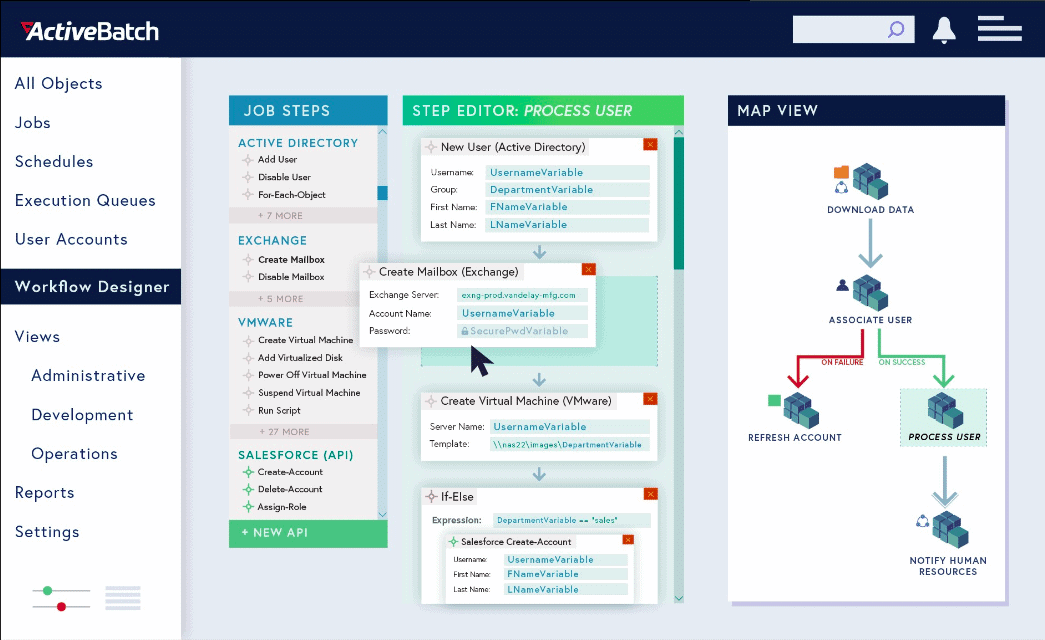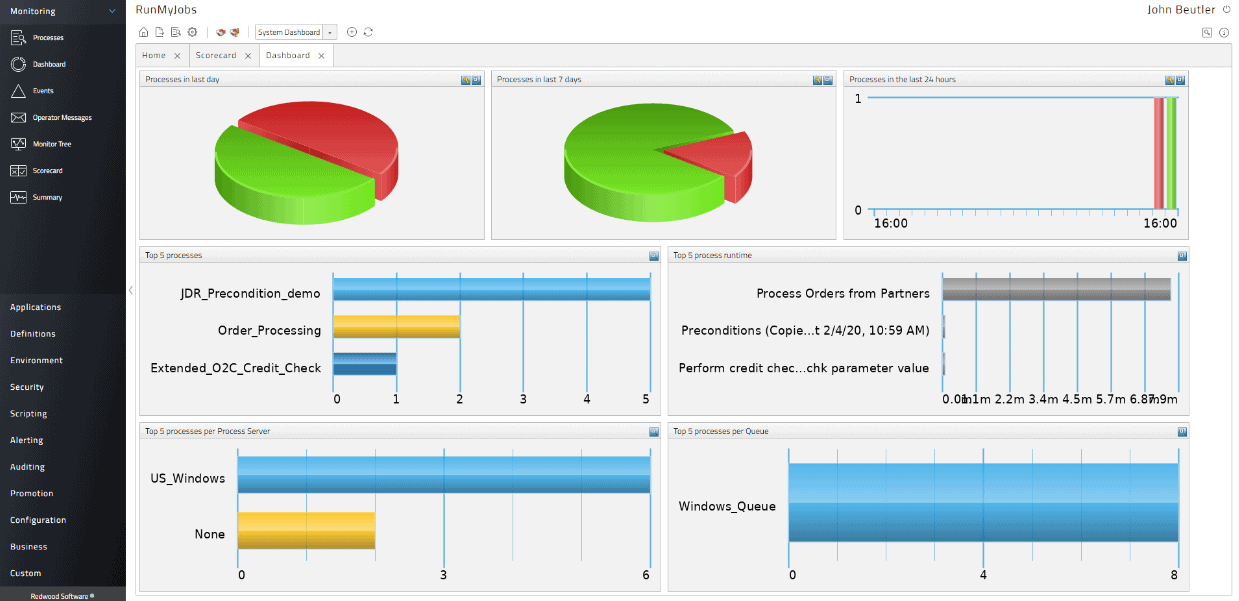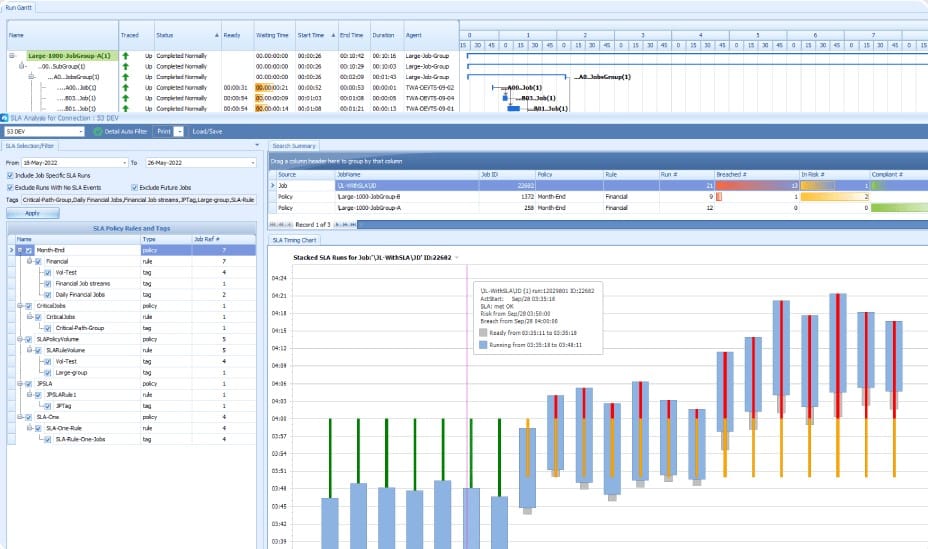Our funding comes from our readers, and we may earn a commission if you make a purchase through the links on our website.
The Best Automic Alternatives

UPDATED: October 26, 2023
Automic Automation is a service orchestration and automation platform that effectively automates your complex and diverse range of technologies, applications, and platforms to help you deliver value.
It can effectively help you to manage complex workflows across business apps, ERP systems, diverse platforms, right from multi-cloud, micro-services to the mainframe. Automic Automation provides the much-needed reliability, speed, and agility to promote seamless business automation. It provides good data governance, self-service, and scaling functionalities to streamline big data pipelines.
With the automation and orchestration capabilities, Automic accelerates your digital transformation and helps you scale efficiently. It supports automation-as-code technology and offers good scalability, self-service, and upgrades with zero downtime.
Here is our list of the best Automic Alternatives:
- ActiveBatch Workload Automation – EDITOR'S CHOICE This task automation package enables the user to create a process flow by linking together different software packages and defining the inputs and output to each stage in the flow. This is a SaaS package that will manage software running on any platform, including the cloud. You can get a demo and then follow up with a 30-day free trial.
- Redwood RunMyJobs – GET FREE DEMO This SaaS-based job scheduler and workload automation service is particularly useful for managing ERPs.
- Tidal Workload Automation – GET FREE DEMO This software scheduler enables separate software packages to form a common platform for data processes and it can be used for software development pipelines or ERP data management, among other applications.
- Control-M A workflow orchestration platform for CI/CD pipelines that includes SLA management utilities. Installs on Windows and is also available as a cloud service.
- JAMS A flexible job scheduling service that can interface with other tools through integrations. Installs on Windows Server.
- IBM Workload Automation An automation platform that can coordinate actions in third-party packages across sites and in the Cloud as well as managing workflows. This is a cloud-based platform.
- Stonebranch A SaaS platform that offers event-based scheduling over on-premises and cloud-based tasks for DevOps environments.
- AutoSys This is a DevOps project supervision system that can work with tasks carried out on-premises or on cloud platforms. Installs on Windows or on a private cloud account.
- Red Hat Ansible This task automation system can be used for configuration management and device onboarding plus secure remote access. Installs on Red Hat Enterprise Linux.
- Azure DevOps Server A great DevOps environment run on the Azure cloud platform that includes development and project management tools.
- OpCon A cross-platform job scheduler that can handle more than 140,000 jobs simultaneously. This is a cloud-based system.
Why look for Automic Alternatives?
Though Automic Automation is agile, reliable, and faster, it can be quite expensive if the end-users ramp up the resources as per their needs.
Another downside of Automic Automation solutions is the lack of customer support. Most modern automation tools offer 24/7 customer support and frequent health checks by a dedicated IT team. Such proactive support is what makes the tool reliable and trustworthy.
In this post, we have summed up reviews of the Top 10 Best Automic Alternatives:
Top best Automic alternatives
1. ActiveBatch Workload Automation – GET DEMO
ActiveBatch Workload Automation is powered by a strong automation engine that allows you to orchestrate any process via a central control pane. In less time, the tool helps you build low-code, reliable end-to-end IT and business processes with the help of fast drag-and-drop actions. Apart from orchestrating workflows, ActiveBatch Workload Automation also improves existing scripts and allows you to integrate any app through API.
Key Features of ActiveBatch Workload Automation:
- Optimizes IT workflows with its intuitive and advanced automation and scheduling capabilities.
- Improved service levels through intelligent resource optimization.
- Spees up troubleshooting with real-time alerting, monitoring, and accessibility on the go.
- Gets unified control over processes and policies for easy compliance.
- Provides version control and rollbacks, audit trails, and access management integrations to provide multiple layers of security for your workloads and data.
- Offers an intuitive workflow designer and a rich set of integrations to boost performance and get in-depth visibility into processes.
- Can be leveraged for business process automation, IT process automation, ETL automation, MFT automation, and more.
- Support for triggers based on schedule and events.
- Features Job Step Library and Low-code GUI.
ActiveBatch is a great Automic Alternative due to the fact that it offers server-based pricing. The client has to pay for execution agents and job schedulers depending on their business needs. ActiveBatch offers all version upgrades and unlimited user access. But in Automic, you have to buy agents for each connection needed, which makes it expensive. Schedule a free demo here.
Pros:
- Centralized automation for all your tools in one place
- Uses a simple drag-and-drop interface to build workflows
- Highly customizable automation, workflows, and scheduling options
- Scales well with enterprises and with growing organizations
Cons:
- Although ActiveBatch is easy to use, the platform has many features that require time to fully explore
Get a FREE Demo of ActiveBatch: advsyscon.com/en-us/demo/get-started
EDITOR'S CHOICE
ActiveBatch is our first selection for an Automic alternative because this SaaS package provides time-saving processes that can replace the work of data entry clerks. The package is able to work out of office hours, enabling you to lighten the load on your network during the day. You can batch process many data management tasks, including data verification and ERP data transfers. System maintenance tasks can be automated with this tool as well, so you get a lot of value for money out of this cloud-hosted package. This system works with the software packages that you already use, so you don’t need to buy a full suite of replacement systems in order to get total task automation.
Download: Get FREE Demo & Trial
Official Site: https://www.advsyscon.com/en-us/demo/quick
OS: Cloud-based
2. Redwood RunMyJobs – FREE DEMO
Redwood is an advanced workload automation solution that reduces unnecessary, time-consuming manual tasks. It offers automation tools for workload and scheduling and report and finance distribution. The solution is built upon a flexible, modern architecture that is meticulously designed to be deployed as-a-service to promote scalability and reap maximum benefits for enterprises. RunMyJobs keeps a clean core with direct integrations to S/4HANA or BTP and 1000+ out of the box SAP wizards and templates. It’s highly recommended for its speed to market and ease of use.
Key Features of RunMyJobs:
- Automates processes across hybrid, cloud, and on-premises environments.
- Centralizes orchestration of automation for ERP systems, Oracle, and SAP.
- Inbuilt SLA monitoring helps you meet critical business process deadlines.
- Coordinate and manage data pipelines to Snowflake, Hadoop, Redshift, and more.
- Offers support for SOAP and REST web services with simple API wizards.
- Provides out-of-the-box connectors to automate any application.
- The fully-hosted infrastructure reduces the costs, complexity, and maintenance lifecycle often involved in automation infrastructure.
- Features single-tenant, security-first design along with full encryption features to highly secure your data and processes.
It is one of the best Automic Alternatives designed for workload automation and job scheduling via SaaS. It has the ability to integrate diverse technologies to boost the digital transformation processes. It provides a unified console for workflows running on-premises, in the hybrid, private and public cloud environments. It fills up the technical gaps in complex processes running between cloud, virtual, distributed, and mainframe resources.
RunMyJobs solution can be used for complex data management, hybrid cloud automation, managed file transfers, and DevOps automation.
We like Redwood RunMyJobs because it is able to link together the execution of an existing suite of software – which might be provided by different vendors – and coordinates their functions to pass through data. Redwood acts like a production line, orchestrating software so that it runs in a sequence, flowing data from one to the next, thus removing the need for manual intervention and eliminating the problem of transposition error. The SaaS package from Redwood improves efficiency and frees up staff for other tasks, making them more productive.
Pros:
- Simple easy to use interface
- Integrates with a wide variety of applications, including ERP systems
- Can implement traffic shaping rules to the job (great for high priority tasks)
- Consumption-based pricing makes RunMyJobs accessible to any size business
Cons:
- Designed for IT professionals, not the best fit for non-technical users
Get FREE Demo: https://www.redwood.com/lp/ex0/ca-automic
3. Tidal Workload Automation – GET DEMO
Tidal Workload Automation enables you to connect software packages from different suppliers into a unified platform. This system is able to process, verify, and reformat data while moving it from one software system to another. Those connected applications can be launched and controlled no matter whether they run on your site or on the cloud.
Key Features of Tidal Workload Automation:
- Allows different software packages to be linked together
- Manages the sequenced execution of nominated software
- Can control and coordinate software that is resident on different platforms
- Will launch a workflow on a schedule
- Can start a workflow on the implementation of a triggering event
- Extracts data from one software package, reformats it, and passes it to another application
- Can be used to manage software releases in a CI/CD pipeline
- Will pre-process and verify data before inserting it into an ERP
- Can disseminate ERP data to other systems
Tidal is useful for many business departments and it can be used to enforce working practices, service level agreements (SLAs), and data governance rules. The tool removes the need for data entry clerks, which saves time and money and removes human error.
Pros:
- Verifies and reformats data
- Can reroute data according to events
- Manages applications running on site and on the cloud within a single workflow
Cons:
- No free trial
You can access a free demo.
Website Link: https://www.tidalsoftware.com/workload-automation/tidal-automation/
4. Control-M
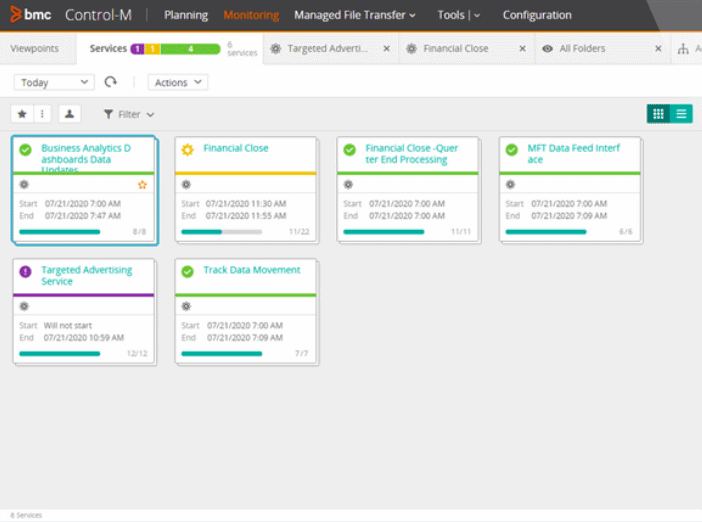
Control-M is another best Automic Alternative that simplifies the orchestration of application workflows. It makes it easier to define, manage, schedule, and monitor workflows so as to improve SLAs and get deeper visibility into processes. It is the best solution for the management of complex business workflows.
Key Features of Control-M:
- Embed workflow orchestration right into your CI/CD pipeline to accelerate new business applications towards production.
- Provides full control over file transfer operations with the help of integrated intelligent file visibility and movement.
- Has a Jobs-as-Code approach to help you scale collaboration between Dev and Ops team.
- Manages big data workloads efficiently to get data-driven results.
- Offers advanced workflow orchestration capabilities and can connect to any data source, any application, and any critical record system.
- Intelligent predictive analytics promotes proactive SLA management.
- Solid support for compliance, governance, and audits.
Control-M offers various functionalities to help you build, define, monitor, and schedule production workflows. The tool can be deployed as a service or on-premises. You can integrate it with GCP (Google Cloud Platform), Azure, and AWS, as it can simplify workloads throughout your multi-cloud and hybrid environments.
Pros:
- Highly customizable tasks, dashboard, and scheduling features
- Supports multiple operating systems such as Linux, Windows, and macOS
- Uses a simple yet informative dashboard for monitoring
Cons:
- Would like to see more workflow visualization options
- Not the best fit for non-technical users
Website Link: https://www.bmc.com/it-solutions/control-m.html
5. JAMS
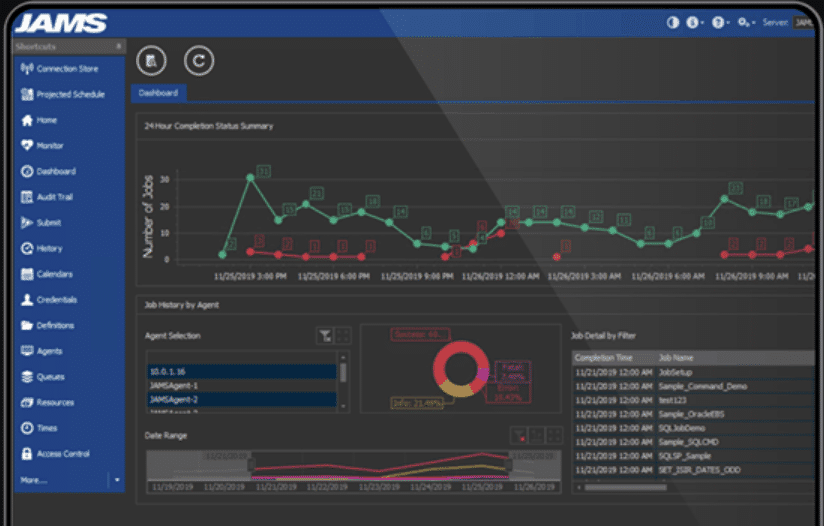
JAMS is an enterprise-grade workload automation solution that simplifies and manages IT processes right from scripts, batch processes to complex cross-platform workflows comprising jobs from multiple applications and servers.
Key Features of JAMS:
- Orchestrates critical business workloads with the help of a centralized set of tools.
- Flexible features help you automate business intelligence, ERP processes, scripts, ETL, and file transfers seamlessly.
- Get information alerts in case of job failure.
- In case of outages, automatically failover to other job schedulers.
- Can distribute jobs to multiple resources to keep up with peak demands.
- Automatically rerun jobs before accepting the failure status.
- Run recovery jobs to mitigate risks.
- Offers clear security roles to schedule and edit jobs.
- Gives right access to the members of off-board, onboard, and automation teams accurately.
- Aligns the automation practices with your regulatory requirements and business policies.
- Financial batch processing allows you to centralize job management via a single console.
- ERP Automation allows you to dynamically connect jobs to make sure they only run when the prerequisites are met.
- Security features allow you to run FTP, ETL, and EDM processes through myriads of servers.
- Execute jobs in parallel or in series.
- Repeat same jobs with the help of series of input variables.
- Automate jobs on any platform, be it Windows, UNIX, Linux, OpenVMS, IBM, and zOS.
- Features native application integrations to execute jobs specific to BI tools, databases, and ERP systems.
- Maintains in-depth audit trails and logs of every single execution.
- Code-driven approach promotes automation for skilled DevOps teams.
- Can automate jobs across all scripting languages, APIs, and platforms.
- Responsive customer support team.
With JAMS, you can effectively define, execute, schedule, and monitor jobs- all via a single intuitive console. Having a centralized control saves enterprise money and time; helps meet compliance standards and mitigate risks to help businesses deliver value. Jobs running on cloud resources, on-premises, or in multi-step workflows execute seamlessly and securely throughout.
JAMS is a flexible tool that can meet the needs of any enterprise, regardless of its size. It has a reliable and robust engine with alerting features that trigger when a workflow fails in remediation. Plus, it offers solid support from a team of expert engineers.
Pros:
- Excellent workflow and data visualizations
- Easy to track assets across multiple workflows
- Designed with enterprises in mind (ERP support, etc)
Cons:
- Smaller organizations might not benefit from all of JAM Schedulers options
Website Link: https://www.jamsscheduler.com/
6. IBM Workload Automation
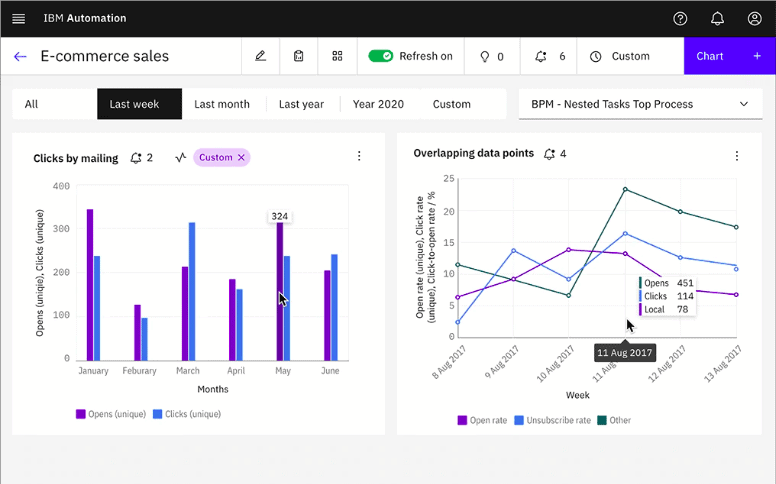
IBM Workload Automation is a power-packed, all-in-one solution for batch and real-time workload automation. It is available for processes hosted in the cloud or those on distributed mainframes.
Key Features of IBM Workload Automation:
- Optimizes workload management by leveraging IBM’s predictive analytics and centralized management.
- Reduces cost of ownership and other costs by eliminating the need for manual tasks for your central server.
- DevOps toolchain allows for greater development agility and integrations to promote business agility.
- Allows customization of workload dashboards with inbuilt widgets.
- Provides governance and autonomy functionalities to Dev and Ops teams along with individual dedicated interfaces.
- Supports integration between containers and workload automation through the deployment of components. You can easily automate applications shifted to containerized environments and even cloud-native applications.
- Features hybrid workload automation to expand the automation environment.
- Automates and schedules the application development and testing. It can promote the applications into production and also provide a rollback option in case something goes wrong.
- Offers more than 35 business integrations to seamlessly integrate with business-critical applications such as Oracle, SAP, Salesforce, Hadoop ecosystem, and more.
- The self-service automation feature allows you to use catalogs and services to submit day-to-day business tasks. It allows you to run and monitor processes on-demand from your smart devices such as tablets and cell phones.
- Provides advanced rerun flexibility. Use Monitor Workload view to rerun job successors and build recovery logic right into job definition.
- Can pass data between jobs and job streams through variable passing feature.
- Uses SOAP, REST, Java, and other APIs to schedule and monitor workloads.
IBM Workload Automation is one of the best Automic Alternatives that can optimize and automate complex IT workflows to boost efficiencies. It is an analytics-based solution that can drastically boost the way you simplify and manage business processes. IBM solution also comprises an intuitive and powerful dashboard and modern streamlined container architecture to simplify the management and deployment of workloads.
Pros:
- Uses graphics well to illustrate automation progress and health
- Provides features applicable to medium-sized and enterprise tier organizations
- Offers numerous planning features and help sysadmin simulate workflows before going live
Cons:
- Can take time to fully explore all features available
Website Link: https://www.ibm.com/products/workload-automation
7. Stonebranch
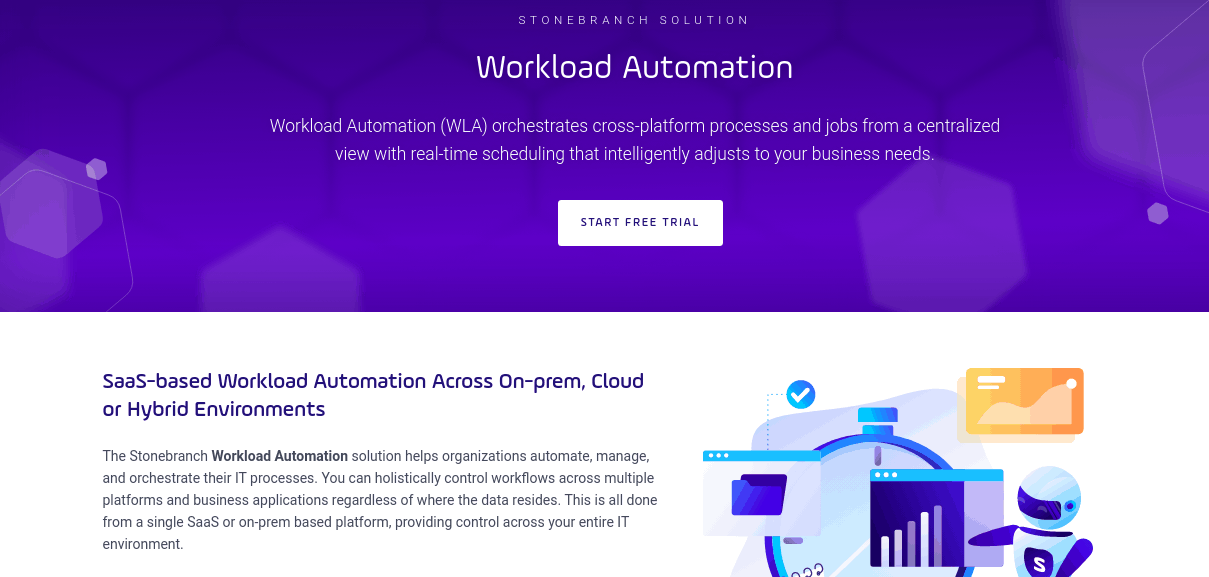
The Stonebranch Workload Automation is designed to help organizations manage, automate and orchestrate IT processes across the entire hybrid environments. It is one of the best Automic Alternatives for real-time hybrid automation.
Key Features of Stonebranch:
- Has intelligent event-based scheduling features.
- Allows for big data management at scale.
- Promotes container-based workload management, automated infrastructure, and native MFT.
- Has features for security, high availability, cost optimization, and compliance.
- Offers centralized control over your entire job scheduling platform. Can holistically control tasks, jobs, scripts, and IT processes running on-premises, in a hybrid cloud, or even multi-cloud environments.
- Helps you achieve real-time automation across the entire hybrid IT environment.
- Allows for self-service automation through member roles and permissions.
- Leverages BI and Analytics for centralized control and insights. Promotes proactive monitoring, reporting, and real-time alerts.
- The drag-and-drop user interface allows you to easily create workflows.
- Advanced features such as Jobs-as-Code, bundle-and-promote, and Infrastructure-as-Code aligns the priorities between your DevOps and IT Ops teams.
- Offers unlimited third-party integrations or lets you download integration blueprints from the open-source marketplace.
Stonebranch is a modern tool developed mainly for workflow orchestration. The powerful hybrid automation platform can orchestrate IT workloads, jobs, and tasks distributed on-premises or on the cloud environments.
It supports on-premise as well as SaaS deployments. Apart from this, it can also be used for DevOps automation, cloud automation, hybrid cloud file transfers, and more.
Pros:
- Supports cloud, multi-cloud, and on-premise automation
- Easily switch automation on or off and create chains of automation across your environment
- Does a great job of centralizing your automation even across more complex networks
Cons:
- Could benefit from more multi-tenant features
Website Link: https://www.stonebranch.com/
8. AutoSys
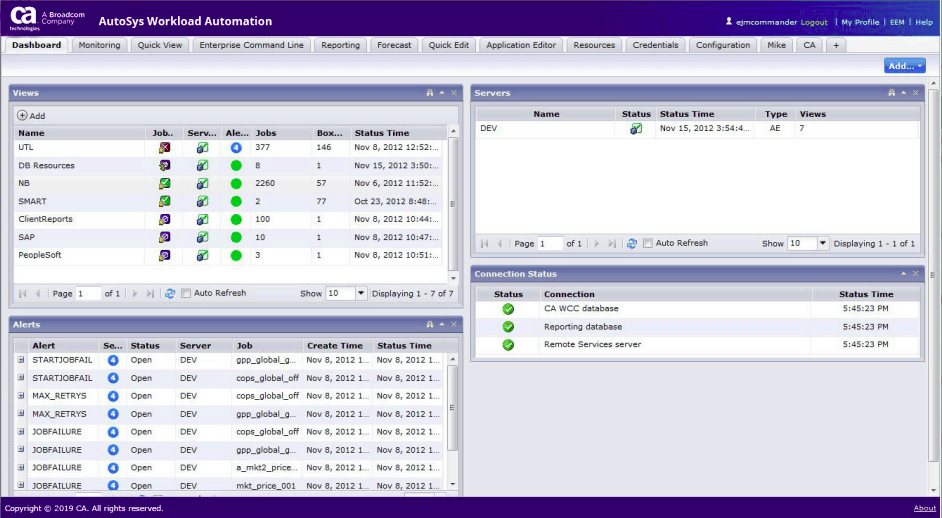
AutoSys is the best Automic Alternative for complex, business-critical workloads. It is a powerful solution used to define, schedule, and monitor jobs across your entire workload infrastructure.
Key Features of AutoSys:
- Offers advanced functionalities for the management of dependencies between traditional and Hadoop jobs.
- Allows Dev teams to write queries against automation engine with the help of Web service.
- Offers native support for SOAP and REST web service protocols.
- Optimizes resource utilization with the help of dynamic workload placement over cloud, virtual and physical resources.
- Features multi-platform scheduling and inbuilt fault tolerance.
AutoSys provides deeper visibility and enhanced control over complex business workloads. It can automate workloads distributed over ERP systems, diverse platforms, and cloud environments. You can deploy the tool partially or entirely on-premises, in the public, private, or hybrid cloud environments.
Pros:
- Designed specifically for more complex enterprise environments
- Supports multi-cloud automation and ERP frameworks
- Offers automation tools designed for developers (great for in house dev teams)
Cons:
- Organizations with simpler workflows would not utilize all the features available in AutoSys
- Not the best fit for smaller organizations
Website Link: https://www.broadcom.com/products/software/automation/autosys
9. Red Hat Ansible
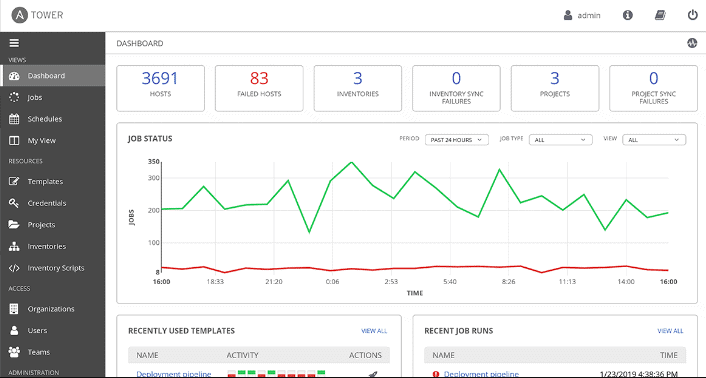
Red Hat Ansible is a feature-packed automation platform that drives automation across your open hybrid cloud deployments. It is an ideal solution for automating IT infrastructure and applications. You can use the tool even if you don't have much knowledge of code.
Key Features of Ansible:
- Speeds up production and helps you manage complex deployments and scale automation.
- It has an agentless architecture.
- Utilizes WinRM and OpenSSH.
- Integrates OpenShift Container with Ansible Automation Platform for simplified and agentless automation.
- Supports automating across containerized workloads and private clouds.
- Helps to provision network devices, bare-metal servers, and storage devices.
- Supports virtualization platforms such as RHV, Vagrant, and VMware vSphere.
- Provides containers and native Kubernetes management. Supports various Kubernetes tooling and frameworks.
- Supports infrastructure integrations for HPE, Red Hat, VMware, Windows, ServiceNow, etc.
Apart from automation, Ansible can be used for provisioning, app deployment, configuration management, continuous deployment, continuous delivery, orchestration, and security compliance.
With Ansible, you can convert tasks into repeatable playbooks. With just a click of a button, you can roll out protocols across your entire enterprise.
Pros:
- Excellent interface, provides high-level insights and easy-to-access details
- Displays and tracks workflows and offers intuitive task scheduling
- Great for collaboration, supports notifications as well as integrations into messaging platforms
- Great options for both small and large dev teams
Cons:
- Offers many different options which can take some time to fully explore
Website Link: https://www.ansible.com/
10. Azure DevOps Server
Azure DevOps Servers consists of a diverse range of collaborative software development tools that allow businesses to share code, monitor workloads, and ship software. It supports on-premises development.
Key Features of Azure DevOps Server:
- Azure DevOps Server comprises modern, agile tools to help businesses plan, track and collaborate seamlessly with business teams.
- Azure Artifacts will help you build, host, and share packages with teams. You can easily add the artifacts to your CI/CD pipelines.
- Get access to more than 100 applications and services through the Extensions Marketplace.
- Access unlimited, cloud-hosted private Git Repos via Azure Repos.
- Offers exploratory and manual testing tools.
- Can integrate with your existing IDE.
Pros:
- Runs natively on Azure
- Includes both development and project management tools
- Integrates well into other Azure tools
Cons:
- Specifically for those who use Azure
Website Link: https://azure.microsoft.com/en-us/services/devops/server/
11. OpCon
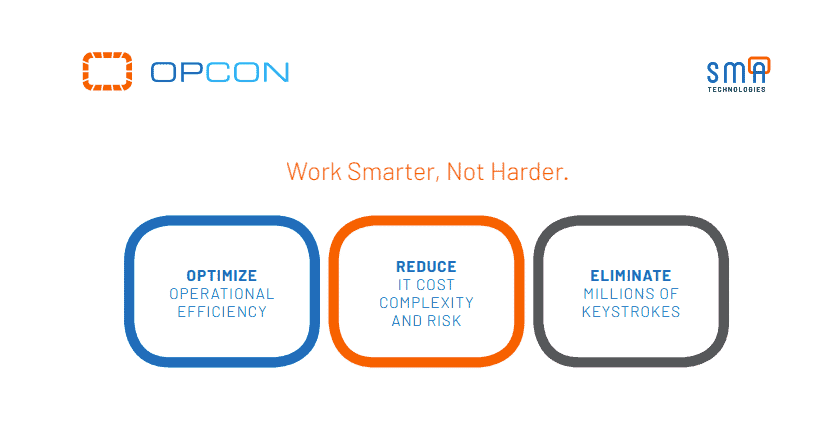
OpCon is a robust and flexible platform that is able to scale up per your requirements. It can run over 140, 000 jobs across multiple operating systems and environments. It can help you seamlessly shift from traditional platforms to new, technology-driven platforms with the help of industry-leading expertise, a rich library of legacy connectors, and REST APIs.
Key Features of OpCon:
- OpCon automation platform delivers ACH processing, Share draft and checking operations, and end-of-day process functionalities.
- All of the three solutions are scalable, reliable, and repeatable.
- These solutions are carefully designed to reduce costs related to manual errors.
- ACH processing helps detect new files and automatically triggers schedules. It can seamlessly integrate with connectors for Fiserv, Symitar, and Correlation. It also offers self-service automation to efficiently handle exceptions. It keeps track of each execution for in-depth audit trials and maintains real-time visibility.
- End of Day Processing executes 24/7 lights-out processing operations. This feature discards the need to work late shifts and odd hours. You can install SLAs along with other recovery actions for maximum flexibility.
- Share Draft and Checking feature automates schedules so you’ll never miss postings. This feature reduces manual key-entry errors and delivers seamless UX with faster processing.
Pros:
- Offers automation migration services – great for complex and critical workflows
- Includes disaster recovery testing
- Focuses on reducing complexity across enterprise automation
Cons:
- Caters to enterprise networks – not the best fit for smaller networks
- Would like to see a free trial version for testing
Website Link: https://smatechnologies.com/opcon-automation
Conclusion
Businesses need to leverage a powerful solution to orchestrate their entire tech stack and centralize workload automation and job scheduling. The tools need to be flexible, reliable, and fast enough to provide unparalleled extensibility and optimization of workflows. These tools also need to have low-code, drag-and-drop GUI for ease of use.
The Automic Automation tool is no doubt one of the best tools available for workload automation. But if you’re looking for Automic Alternatives, then ActiveBatch and other alternatives mentioned here are quite intuitive, reliable, and offer good customer support.

